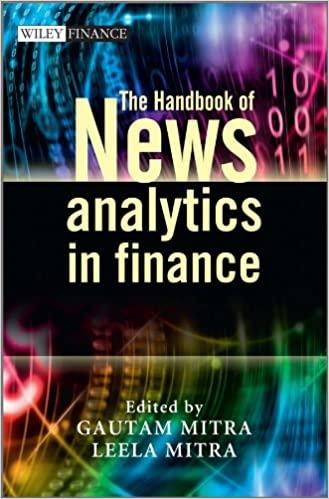Answered step by step
Verified Expert Solution
Question
1 Approved Answer
answer question 5,6,7 only MINI-CASE BioCom, Inc.: Part 1 BioCom was founded in 1993, when several scientists and engineers at a large fiber-optic-cable company began
answer question 5,6,7 only 

MINI-CASE BioCom, Inc.: Part 1 BioCom was founded in 1993, when several scientists and engineers at a large fiber-optic-cable company began to see that optical fiber for the telecommunica- tions industry was becoming a cheap commodity. They decided to start their own firm, which would specialize in cutting-edge applications for research in the life sci- ences and medical instruments, BioCom is now one of the leading firms in its niche field. BioCom's manage- ment attributes the firm's success to its ability to stay This mini-case is available in MyLab Finance. one step ahead of the market's fast-changing techno- logical needs. Almost as important is BioCom's ability to select high-value-added projects and avoid commer cial disasters. Over lunch, BioCom's director of research and development (R&D) mentioned to the CFO that one of his best young scientists had recently left the com- pany because his line manager had rejected his proj- ect. Although not a pattern, R&D had experienced Mini-Case Cash Flow Nano Test Tubes 297 Microsurgery Investment Cash flow year 1 Cash flow year 2 Cash flow year 3 Cash flow year 4 Cash flow Year 5 -$11,000 $ 2.000 $3,000 $ 4,000 $ 5,000 $ 7,000 $11,000 $ 4.000 $ 4,000 $ 4,000 $ 4,000 $ 4,000 2. Compute the discounted payback period for each project using a discount rate of 10% Explain the rationale behind the discounted payback method. b. Comment on the advantages and hosting of this method 3. Compute the net present value for each project Com uses a discount rate of for projects of similar losses in the past. The two executives dis- cussed the problem and agreed that if the R&D people understood the selection process better, they might come up with more commercially viable projects and understand the project's financial implications. The CFO then asked his assistant, Jane Donato, to prepare a retreat for the R&D department to explain the company's project selection procedures. Jane is encouraged by the thought that this group will have no trouble in following the math! BioCom's standard capital request form includes a narrative description of the project and the customer need that the company must fulfill. If the request originates with R&D, it then goes to the marketing department for a preliminary sales forecast and then to the production manager and cost analysts for cost esti- mates. If a proposal shows promise after these steps, It goes to the CFO, who has a staff member enter the data into a spreadsheet template. The template computes payback, discounted payback, net present value, inter- nal rate of return, and modified internal rate of return. BioCom uses net present value as its primary decision criterion, but company executives believe that the other statistics provide some useful additional perspectives. To explain BioCom's capital budgeting tech- niques, Jane has decided to present the cash flows from two recent proposals: the nano test tube project and the microsurgery kit project. All figures are in thousands of dollars average risk 2. Explain the rational behind the NPV method. b. Sute and explain the decision rule for the NPV method c. Explain how the company would use the NPV method to rank mually exclusive projects d. Comment on the advantages and shortcoming of this method e. Without performing any calculations, explain what happens to the NPV if the company ad justs the discount rate upward for projects of higher risk or downward for projects of lower risk. 4. Compute the internal rate of return for each project. a. Explain the rationale behind the IRR method. b. State and explain the decision rule for the IRR method. Assume a hurdle rate of 9% c. Explain how the company would use the IRR method to rank mutually exclusive projects d. Comment on the advantages and shortcomings of this method 5. Compute the modified internal rate of return for each project a. Explain the rationale behind the MIRR method b. State and explain the decision rule for the MIRR method. Assume a hurdle rate of 9% c. Explain how the company would use the MIRR method to rank mutually exclusive projects d. Explain how this method corrects for some of the problems inherent in the IRR method. 6. Explain to the R&D staff why BioCom uses the NPV method as its primary project selection criterion. 7. Challenge question Construct NPV profiles for both projects using discount rates of IX through 15% at intervals of one percentage point. At ap- proximately what discount rate does the nano test tube project become superior to the microsurgery kit project? You are better off solving this problem using an electronic spreadsheet. Help Jane answer the following questions Questions 1. Compute the payback period for each project. a. Explain the rationale behind the payback method b. State and explain the decision rule for the pay- back method c. Explain how the company would use the payback method to rank mutually exclusive projects d. Comment on the advantages and shortcomings of this method 

Step by Step Solution
There are 3 Steps involved in it
Step: 1

Get Instant Access to Expert-Tailored Solutions
See step-by-step solutions with expert insights and AI powered tools for academic success
Step: 2

Step: 3

Ace Your Homework with AI
Get the answers you need in no time with our AI-driven, step-by-step assistance
Get Started


